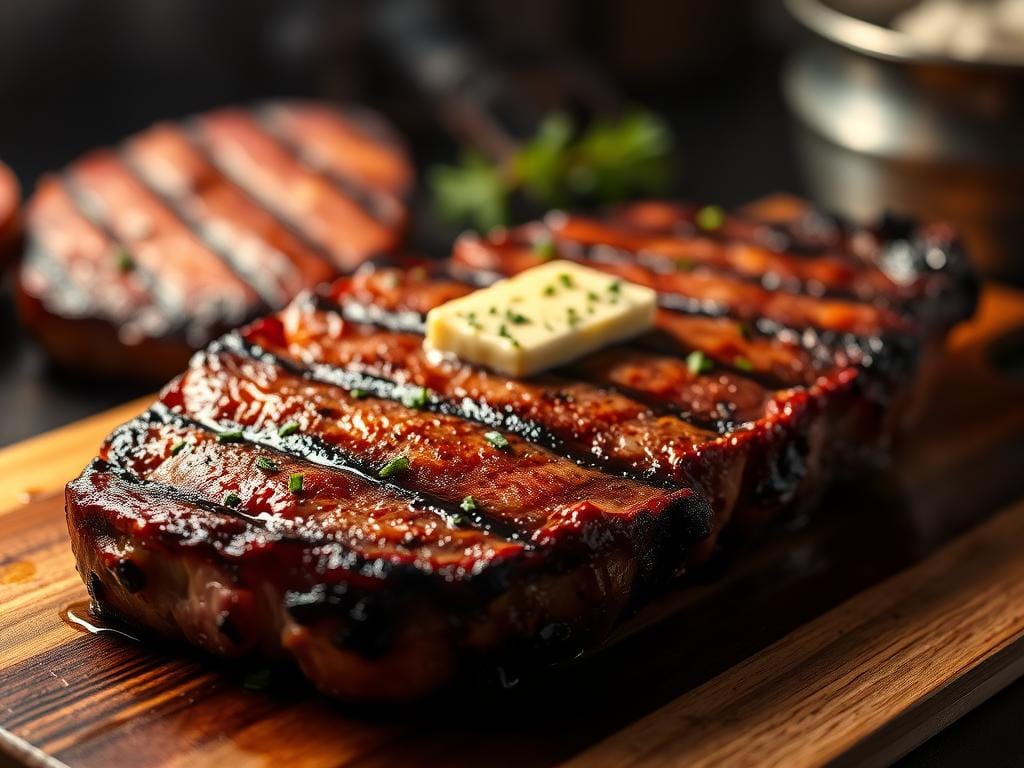The sizzle of a perfectly grilled ribeye steak can turn a simple meal into a memorable experience. Every home cook wants to make that restaurant-quality beef. They aim for a golden-brown crust and a tender, juicy inside.
If you love hearty and flavorful beef dishes, you might also enjoy a lighter yet equally delicious alternative. Check out The Ultimate Ina Garten Turkey Meatloaf Recipe for a juicy, tender twist on a classic meatloaf
Ribeye steaks are the top choice for beef lovers. They come from the rib primal section, known for their marbling and rich flavor. Grilling a ribeye is more than cooking meat. It’s about creating a memorable dining experience for your family and friends.
Whether you’re an experienced griller or just starting, this guide will help you. You’ll learn how to make the most delicious grilled ribeye steak in your backyard.
Key Takeaways
- Ribeye is the most flavorful cut of beef
- Proper grilling technique is key for perfect results
- Marbling makes the steak tender and flavorful
- Keeping the right temperature is important for doneness
- Letting the steak rest is essential for juiciness
Understanding the Perfect Ribeye Cut
The ribeye is a top choice for steak lovers. It offers a unique taste that makes grilling special. To find the perfect ribeye, you need to know what makes it special and how to pick the best one.
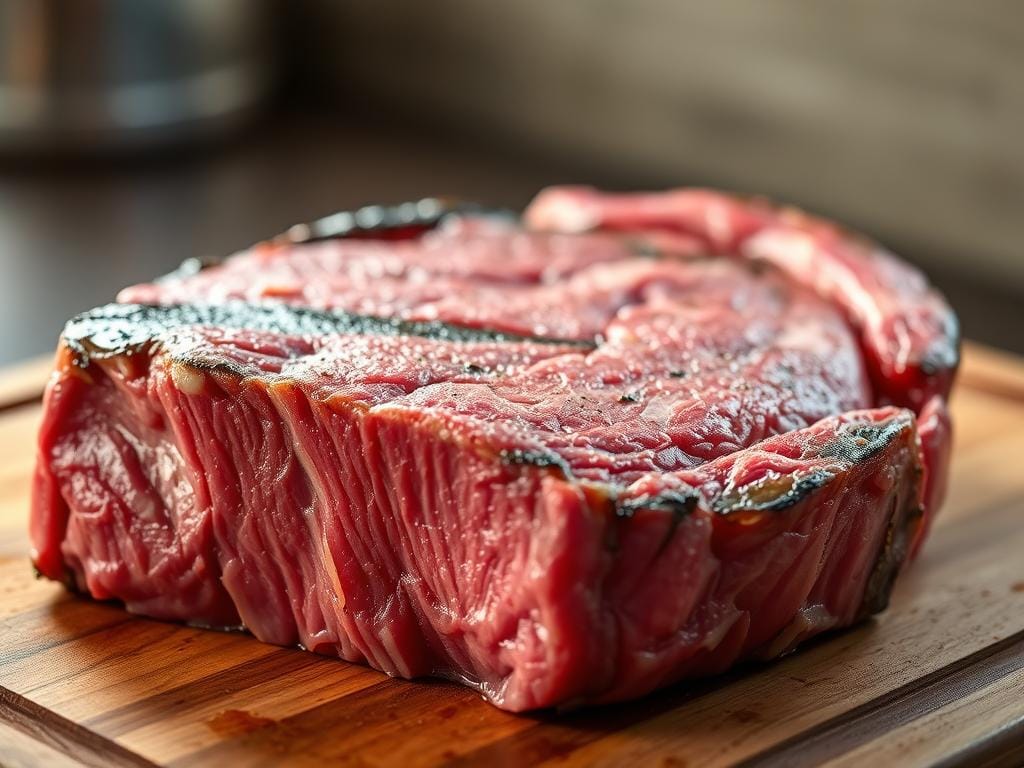
Ribeye steaks come from the cow’s ribs 6-12. They should be at least 1 inch thick. Chefs often choose cuts between 1.25 to 1.5 inches for the best grilling.
What Makes Ribeye Special
The ribeye’s magic is its marbling. This fat network makes the steak tender and full of flavor. It’s made up of several muscles, including:
- Longissimus Dorsi (the eye of the ribeye)
- Spinalis Dorsi (the ribeye cap)
- Additional supporting muscle groups
Choosing the Best Quality Steak
Not all ribeyes are the same. Look for these key things when picking your steak:
- Check for consistent marbling
- Look at the color (fresh steaks are bright red)
- Choose the grade (USDA Prime is the best)
Marbling and Grade Selection
Marbling greatly affects the steak’s taste and tenderness. More fat means a richer flavor. Dry aged ribeyes have a deeper taste, best after 4 weeks of aging.
| Beef Grade | Marbling Level | Recommended Use |
|---|---|---|
| USDA Prime | Abundant | Highest quality grilling |
| USDA Choice | Moderate | Great for most home cooking |
| USDA Select | Minimal | Budget-friendly option |
Pro tip: Always choose a ribeye with consistent, fine-textured marbling for the most succulent grilling experience.
Essential Preparation Steps for Grilled Ribeye
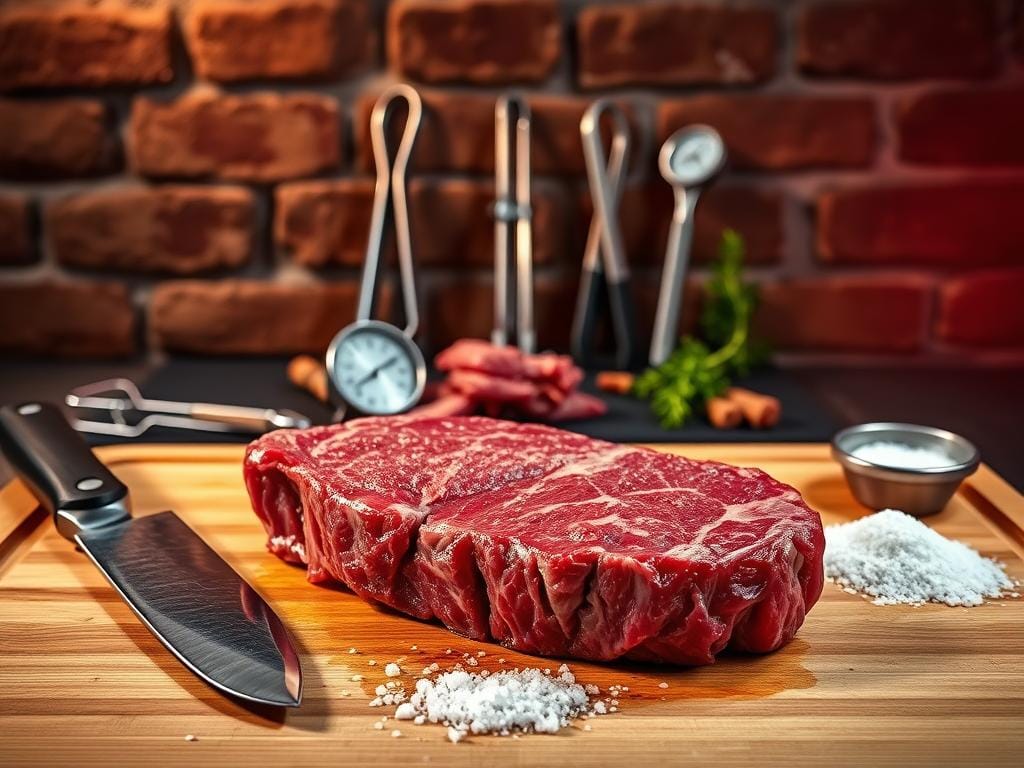
Getting a perfect ribeye steak ready for the grill needs focus. The secret to a great grilled ribeye is in the prep work. Knowing the key steps can make your steak go from good to amazing.
Temperature is key when getting your ribeye ready for marinating and grilling. Let your steak sit at room temperature for about 30 minutes before cooking. This step helps the heat spread evenly, avoiding a cold center and ensuring a perfectly seared outside.
Preparation Checklist
- Remove steak from refrigerator 30 minutes before grilling
- Pat steak dry with paper towels
- Season generously with salt and pepper
- Lightly brush with olive oil
Seasoning is important for bringing out the beef’s natural flavor. A simple salt and pepper approach works best for ribeye. Use kosher salt and freshly ground black pepper, applying them generously about 45 minutes before cooking. This lets the seasoning soak into the meat, creating a tasty crust during grilling.
Recommended seasoning measurements for a typical ribeye steak:
| Seasoning | Amount |
|---|---|
| Kosher Salt | 1-2 teaspoons |
| Black Pepper | 1 teaspoon |
| Olive Oil | 1 tablespoon |
Proper preparation turns an ordinary steak into a memorable barbecue experience. By following these essential steps, you’ll make a ribeye that’s juicy, flavorful, and cooked just right.
Mastering the Grilled Ribeye Technique
Grilling the perfect ribeye steak needs skill and precision. Your success in barbecue depends on mastering key techniques. These techniques turn an ordinary cut into a restaurant-quality dish.
Proper Grill Temperature Settings
Getting the right grill temperature is key for a delicious ribeye. Heat your grill to 325-350℉. This temperature is perfect for grilling.
High heat starts the Maillard reaction. This reaction creates a rich, brown crust. It seals in the steak’s juices.
| Temperature Range | Cooking Outcome |
|---|---|
| 325-350℉ | Optimal Ribeye Grilling |
| 450-500℉ | High Sear Temperature |
Searing and Cooking Methods
For great grilling, use the two-zone cooking method. Start with direct high heat for searing. Then, move to indirect heat for even cooking.
This method gives you a crispy outside and a juicy inside.
- Sear each side for 4-6 minutes
- Move to indirect heat for 5-8 minutes
- Aim for internal temperature based on desired doneness
Flipping and Timing Guidelines
Flip your steak only once during grilling. This usually happens 6-8 minutes after placing it on the grill. Use a meat thermometer to check the internal temperature.
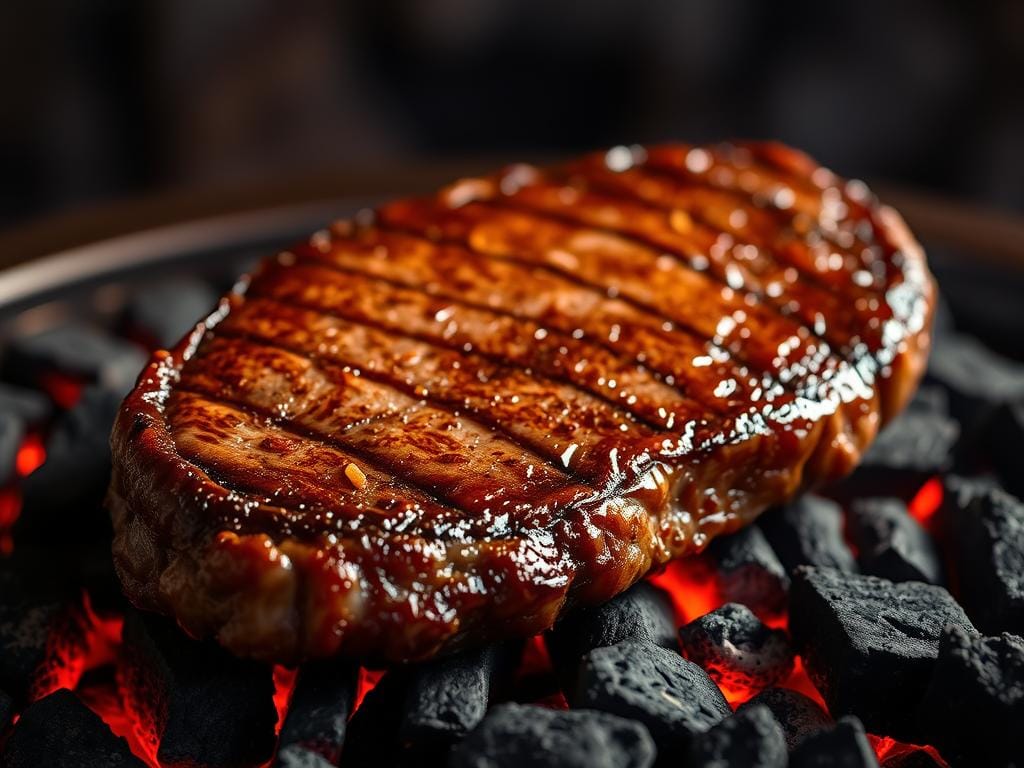
Pro tip: Let your ribeye rest for 15 minutes after grilling. This helps redistribute juices, making your meal tender and flavorful.
Temperature Guide and Doneness Levels
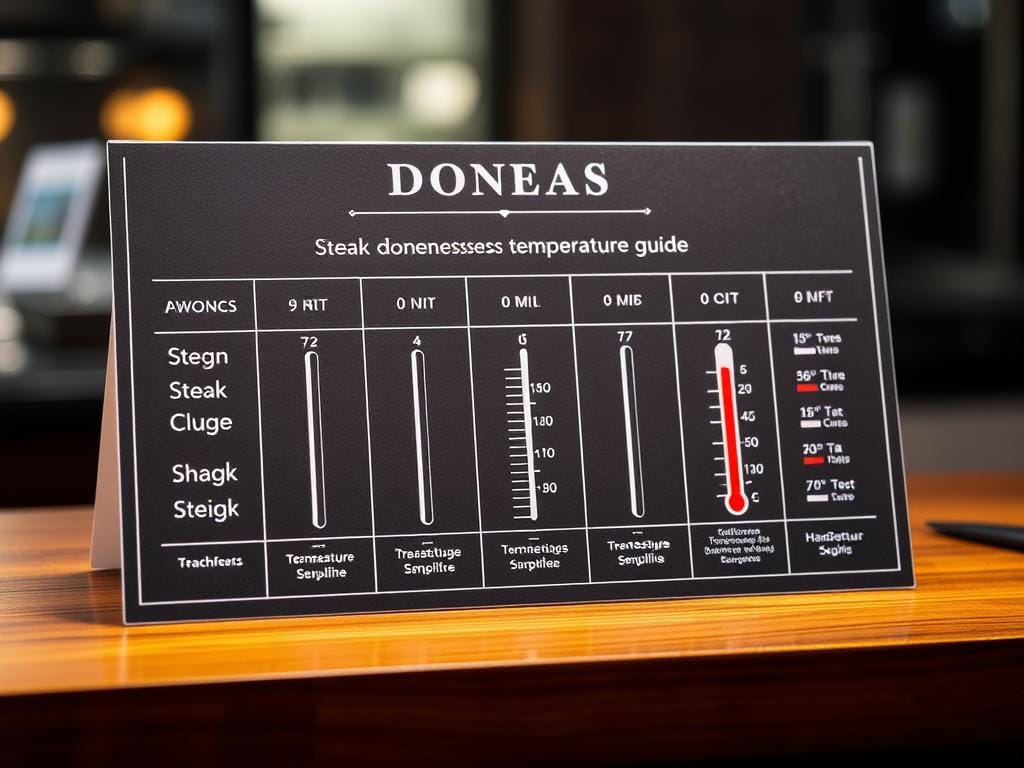
To get the perfect steak, you need to know about internal temperatures and doneness levels. The taste and texture of your beef depend on how well you control the heat.
Professional chefs always use a meat thermometer. It’s the best way to check the temperature. Different doneness levels offer different tastes and textures, from soft and juicy to firm and well-done.
| Doneness Level | Temperature Range | Characteristics |
|---|---|---|
| Rare | 120-130°F | Cool red center, very soft texture |
| Medium Rare | 130-135°F | Warm red center, most popular among steak enthusiasts |
| Medium | 135-145°F | Warm pink center, balanced flavor |
| Medium Well | 145-155°F | Slightly pink center, less juicy |
| Well Done | 155°F and above | No pink, firm texture |
Here are some important tips for grilling beef:
- Pull steaks from heat 5°F below desired temperature
- Allow 5-10 minutes resting time after cooking
- Expect 3-5°F temperature rise during resting
Pro tip: Ribeye steaks shine when cooked to medium-rare, preserving their rich marbling and exceptional flavor.
The final temperature of your steak depends on several things. These include the steak’s thickness, the cooking method, and its initial temperature. Try different temperatures to find your favorite doneness!
Best Seasonings and Toppings for Ribeye
Take your grilled ribeye to the next level with the right seasonings and toppings. The perfect mix can turn a simple steak into a feast for your taste buds. It will also wow your guests.
Classic Salt and Pepper Approach
The classic salt and pepper method is unbeatable for seasoning a grilled ribeye. Use Kosher salt and freshly ground black pepper, generously applied 40-45 minutes before cooking. This lets the salt create a brine, boosting the steak’s flavors.
- Use 2 tablespoons of Kosher salt
- Add 1-2 tablespoons of freshly ground black pepper
- Ensure even coverage across the entire surface
Dry Rub Options
For deeper flavors, try homemade dry rubs on your grilled ribeye. A mix can include:
- 1 tablespoon smoked paprika
- 1 tablespoon garlic powder
- 1 teaspoon onion powder
- 2 teaspoons dried rosemary
- 2 teaspoons dried thyme
Compound Butter Variations
Compound butters add a luxurious touch to your grilled ribeye. Mix softened butter with herbs, garlic, or blue cheese crumbles for a rich topping.
Pro tip: For a top-notch cowboy cut, try different compound butter flavors. A classic herb butter with parsley, chives, and roasted garlic can make your steak taste like it’s from a restaurant.
Conclusion
Getting great at grilling ribeye takes time, effort, and knowing the basics. Your BBQ skills will get better by following key steps. These include letting the steak warm up, seasoning it right, and cooking it just right.
To make an amazing grilled ribeye, start with top-notch meat. Learn how to control the temperature and don’t skip the resting time. Letting it rest for 5 minutes makes it juicy and full of flavor.
Your BBQ skills will make your home cooking stand out. By watching the internal temperature, seasoning well, and grilling consistently, you’ll make steaks that wow everyone. It’s all about the details.
Grilling ribeye is a skill that grows with practice. Every time you grill, you learn more about timing, temperature, and technique. Enjoy the learning and soon you’ll be making delicious, tender ribeye steaks.
FAQ
Q: What makes ribeye steak different from other cuts?
A: Ribeye stands out because of its rich marbling. This marbling adds flavor and tenderness. The fat in the meat makes it taste like butter and feel tender.
Q: How do I choose the best quality ribeye steak?
A: Look for steaks with lots of marbling and USDA grades like Prime or Choice. Choose cuts with white fat, a bright red color, and thick marbling. Steaks about 1.5 to 2 inches thick are best for grilling.
Q: Should I choose bone-in or boneless ribeye?
A: Bone-in ribeyes taste better and are juicier. Boneless ones are easier to cut and cook evenly. Your choice depends on your grilling style and preference.
Q: How long should I let my ribeye rest before grilling?
A: Take your steak out of the fridge 30-45 minutes before grilling. This lets it warm up evenly. It prevents the outside from burning before the inside is cooked right.
Q: What’s the best way to season a ribeye?
A: Use kosher salt and black pepper. Season it well 40 minutes before grilling. For more flavor, try a dry rub or make your own seasoning mix.
Q: How do I achieve the perfect sear on my ribeye?
A: Heat your grill to 450-500°F. Use direct and indirect heat zones for grilling. Sear the steak for 2-3 minutes on each side. Then, move it to indirect heat to finish cooking.
Q: What internal temperature indicates my preferred doneness?
A: Here are the temperatures for different doneness levels:
– Rare: 125°F
– Medium Rare: 135°F
– Medium: 145°F
– Medium Well: 150°F
– Well Done: 160°F
Always check with a meat thermometer. Remember, the temperature will rise a bit while the steak rests.
Q: How long should I let my steak rest after grilling?
A: Let your ribeye rest for 5-10 minutes after grilling. This lets the juices spread out, making the steak tender and flavorful. Cover it with foil to keep it warm.
Q: Can I use a marinade on ribeye?
A: Ribeye is tasty on its own, but a light marinade can add more flavor. Avoid acidic marinades that can make the meat tough. Choose herb or oil-based marinades instead.
Q: What’s the difference between dry-aged and regular ribeye?
A: Dry-aged ribeye is aged for weeks or months. This process makes the meat more tender and flavorful. It also gives it a unique, nutty taste compared to regular beef.

